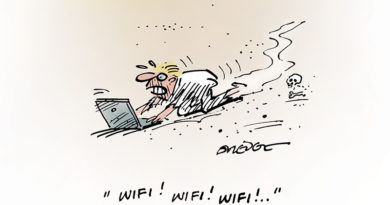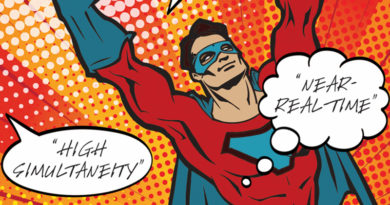Pandemic Ponderings
By Leslie Ellis
Like everyone in this edition, I’m writing this while sheltering-in-place. In my case, in Denver, with a new puppy named Etta. It is just past the middle of April. Things allegedly start re-opening here next week. I think we can all agree: It’s been a strange couple of months.
It’s tricky to sort out what we’ll be thinking about, and where our heads will be, six weeks hence, when this edition drops. If you work for a service provider, you’ve been redirecting/reprioritizing your work towards keeping the front lines, and customers, safe. If you work for a supplier, you’ve been chasing down the administrivia of trade show and event cancellations, while deciding what your “rest of 2020” plan is.
I’ve been keeping my curiosity pointed at technologies and innovations breaking into the pandemic mainstream. Starting with the greatest unsung hero in this story so far: The network itself. The connectivity. Our nation’s broadband networks started beefing up for gigabit-grade services a few years ago — despite the fact that nobody really needed that much raw bandwidth at the time. As a consequence, they’re now quietly and relentlessly responding to a 30% surge in usage, coincident with us all working from home, for real. For a useful roundup of network-related COVID-19 stats, developed by the NCTA and refreshed weekly by the industry’s CTOs, go to ncta.com/COVIDdashboard.
As someone who grew up watching this industry widen its available bandwidth — I came in during the shift from 450 MHz to 550 MHz plant — I can say with gusto that when I go outside at 8PM to make noise for the front lines, I bang a gong and howl (Governor’s orders!) for the traffic shapers, backbone keepers, load balancers, and every single one of you who keep the nation’s (and the globe’s) Internet spigots zooming along. (Pun very specifically intended.)
Another batch of headlines I’m following involves robots and automation. As someone gratefully involved in cableFIRST — loosely an SCTE and WICT mission to link industry talent with the high school robotics teams affiliated with Dean Kamen’s FIRST program — I was tickled and not surprised to learn about how a Michigan team repurposed its 2020 season robot, after all regional and global FIRST competitions were shuttered for the year. Get this: They made a ventilator out of it. (!)
Robotics and automation rose to the surface because they can’t catch viruses. They’re perfect for tasks that are repetitive, sure, but they’re even more perfect for doing things that are too strenuous (think stacks of heavy boxes in a warehouse) or too unsafe (germs, fumes) for humans. Several stories emerged about robots outfitted with UV light arrays, to disinfect surfaces in hospitals, workplaces and prisons.
(Aside: Here in Denver, a young work friend got so intrigued, she built one herself. In her bathtub, because of space limitations and pets. Last I heard, it worked, but, questions remain about how well UV lights get along with data center and headend equipment, like lasers.)
Automation, which pre-pandemic seemed rooted in the “nice to have” and “let’s keep an eye on it” categories, stepped up in lockstep with our digital lives. Another work friend spent the last few weeks extending her company’s chatbot and self-help platforms further into the product suite, to make it better for customers — and to lighten the load on a care workforce as double-digit-thousands of them transitioned to working from home.
Still others plotted how to deal with what will be an unnervingly large backlog of in-home visits, once technicians can safely resume in-home visits. Or how to make our Wi-Fi lives better, in all sorts of ways, but especially in ways customers can do themselves.
We’re lucky to work in an industry that has many Special Gifts. High among them is our proclivity to come together during a crisis, treat each other as family, and lift really heavy things for the greater good. This is another of those times. Thanks again to the keepers of the network! Proud to know you!
Feature Image from Ollie and Etta

 Leslie Ellis,
Leslie Ellis,
President,
Ellis Edits Inc.
leslie@ellisedits.com
Leslie Ellis is a tech writer focused on explaining complex engineering stuff for people who have less of a natural interest than engineers. She’s perhaps best known (until now!) for her long-running weekly column in Multichannel News called “Translation Please.” She’s written two broadband dictionaries, one field guide to broadband, and is a behind-the-scenes tech translator for domestic and global service providers, networks, and suppliers. She’s served as board member of the Rocky Mountain chapter of the SCTE since 2015, and is a 2019 Cable Hall of Fame inductee.




